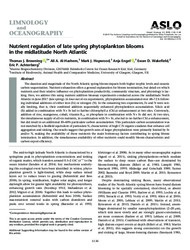Nutrient regulation of late spring phytoplankton blooms in the midlatitude North Atlantic
Al-Hashem, Ali A.
Wakefield, Ewan D.
DOI: https://doi.org/10.1002/lno.11376
Persistent URL: http://resolver.sub.uni-goettingen.de/purl?gldocs-11858/9313
Persistent URL: http://resolver.sub.uni-goettingen.de/purl?gldocs-11858/9313
Browning, Thomas J.; Al-Hashem, Ali A.; Hopwood, Mark J.; Engel, Anja; Wakefield, Ewan D.; Achterberg, Eric P., 2019: Nutrient regulation of late spring phytoplankton blooms in the midlatitude North Atlantic. In: Limnology and Oceanography, Band 65, 6: 1136 - 1148, DOI: 10.1002/lno.11376.
 |
Dokument öffnen: |
The duration and magnitude of the North Atlantic spring bloom impacts both higher trophic levels and oceanic carbon sequestration. Nutrient exhaustion offers a general explanation for bloom termination, but detail on which nutrients and their relative influence on phytoplankton productivity, community structure, and physiology is lacking. Here, we address this using nutrient addition bioassay experiments conducted across the midlatitude North Atlantic in June 2017 (late spring). In four out of six experiments, phytoplankton accumulated over 48–72 h following individual additions of either iron (Fe) or nitrogen (N). In the remaining two experiments, Fe and N were serially limiting, that is, their combined addition sequentially enhanced phytoplankton accumulation. Silicic acid (Si) added in combination with N + Fe led to further chlorophyll a (Chl a) enhancement at two sites. Conversely, addition of zinc, manganese, cobalt, vitamin B12, or phosphate in combination with N + Fe did not. At two sites, the simultaneous supply of all six nutrients, in combination with N + Fe, also led to no further Chl a enhancement, but did result in an additional 30–60% particulate carbon accumulation. This particulate carbon accumulation was not matched by a Redfield equivalent of particulate N, characteristic of high C:N organic exudates that enhance cell aggregation and sinking. Our results suggest that growth rates of larger phytoplankton were primarily limited by Fe and/or N, making the availability of these nutrients the main bottom-up factors contributing to spring bloom termination. In addition, the simultaneous availability of other nutrients could modify bloom characteristics and carbon export efficiency.
Statistik:
ZugriffsstatistikSammlung:
This is an open access article under the terms of the Creative Commons Attribution License, which permits use, distribution and reproduction in any medium, provided the original work is properly cited.

